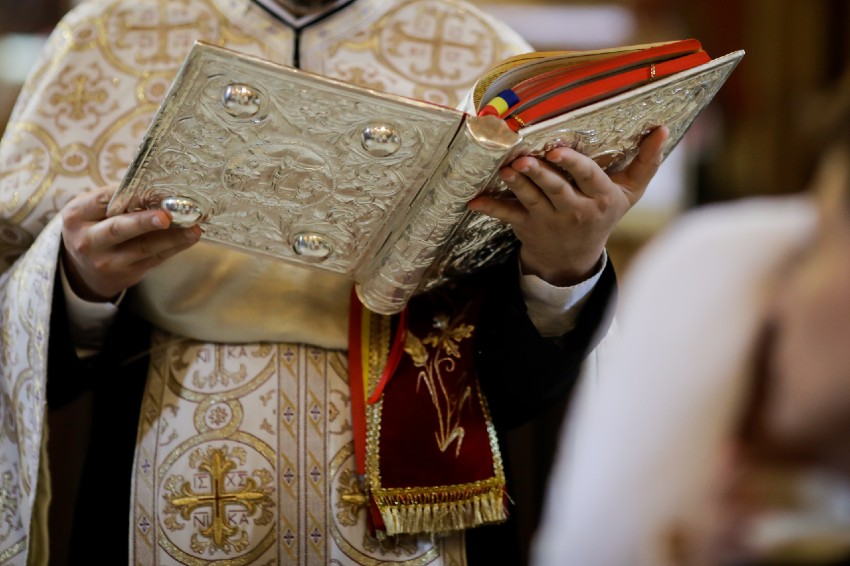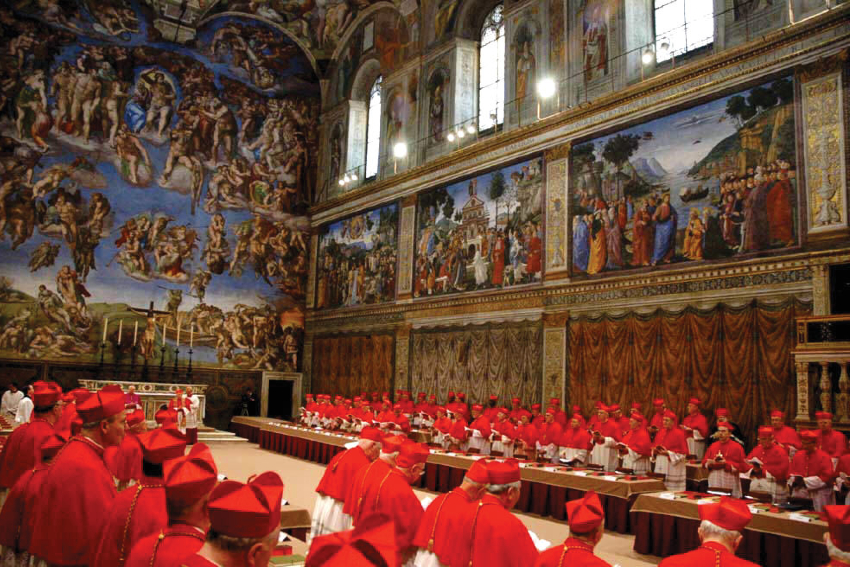April 15, 2017, Holy Saturday
From Norcia to Chieti
During Holy Saturday, on the Vigil of Easter, silence.
Time to stand apart. To stand aside. To divest of all, thoughts, hopes, judgments, even fears.
To divest, to unclothe, as did Francis of Assisi, before the bishop of Assisi in 1207, when he gave back everything to his father, Pietro di Bernardone, and declared through this action that he did not live by bread and cloth alone, but by every word that comes from the mouth of the eternal God.
And appropriately, the place where this occurred, where Francis stripped off his clothes and began his new life, will now become a shrine, the Shrine of the Despoliation, of the Unclothing, in the bishops’ house in Assisi, next to the Church of St. Mary Major.
I went there on Wednesday, as has become my habit each Holy Week, with two pilgrim friends, to pray for peace in this contested, fallen world.
We met briefly with the bishop of Assisi, Domenico Sorrentino, and he chanted for us the Canticle of the Creatures which Francis composed 800 years ago.
The letter of Pope Francis approving of the new shrine will be published tomorrow.
On Thursday, we traveled on to Norcia, where we saw the tumbled stones which the earthquake shook down in October, wrecking all the churches of Norcia, and large parts of the city walls.
We walked in the street and chatted with shopkeepers who told us they have reopened their business 15 days ago, and have few clients. As many as 30% of the citizens of Norcia seem to be on the verge of deciding to live elsewhere and not to return, lest another earthquake come in the years ahead.
Then we drove up the hill to see the Benedictine monks, and we found 14 of them on the hillside above Norcia, building a new monastery, this time out of wood, not stone. We asked them what they still needed to finish the building, and they told us a modest sum, everything considered: $100,000. If someone would feel moved to support the Benedictine monks of Norcia in rebuilding their monastery, and would like to help in a substantial way, now would be a good time to do so.
We spoke with Father Cassian Folsom, whose face is etched with a certain detachment now. He was standing by the Basilica of St. Benedict on the morning of October 30, about to go inside to celebrate Mass, though the tremors on the 26th had led him to decide to move all of the monks outside of the city for the time being. And then, the earth shook. And the basilica fell down, the roof first, then the tops of the walls, then all the walls except the facade. And as he stood there, with dust and occasional small pieces of stone splintering down onto him, he saw 20 years of his life’s work come crashing down into rubble.
“But God was good to us,” Cassian told us. “No one was hurt. No one died. We were all safe, because we had left after the earlier quake.”
Cassian, too, could have died. It was a matter of minutes. Had he gone inside, the roof would have fallen on him.
He has now stepped aside from the Priorship, and his younger fellow monk, Father Benedict, has become Prior. Benedict is energetic, and is focused on rebuilding the monastery on the hillside.
“He is better suited to the task than I am,” Father Cassian said to us.
And then they went inside to celebrate the Mass of the Lord’s Supper. It was all in Latin, all in keeping with the 1962 Missal, and it seemed simple and ordinary to me, and solemn and good, as I remembered the Masses of my childhood.
There, the new Prior washed the feet of Father Cassian and the other monks.
And all of us present felt privileged to see these men living their faith on the mountainside above Norcia, despite all that they have endured — a freezing winter in tents, sometimes with no running water, and the darkness of the long winter nights…
That was Thursday… Holy Thursday… And it will always seem to me now to be a time of a second despoliation, a second unclothing, for Father Cassian and his monks lost all in the earthquake, and gave up all, just as Francis gave up all 800 years ago in Assisi.
Then we went on to Chieti, where yesterday at 5:30 pm we attended a Good Friday service, which included communion and the veneration of the cross, in the Cathedral of Chieti, followed by a procession around the city lasting two hours — a procession which scholars say dates all the way back to the very earliest years of the Christian faith in Italy, nearly 2,000 years.
In our time, a time when the faith is being forgotten in our culture, the entire city of Chieti yesterday, as it does each year, recalled the faith in a unique way.
On Good Friday, 120 violinists and more than 200 members of a choir playing and singing the Miserere of Selecchy, then marched around the city, still playing and singing. They were joined by dozens of men in a holy Catholic order who carry the symbols of the Passion on their shoulders — the cross, the washbasin where Pontius Pilate washed his hands, the dice that the soldiers used to cast lots for Christ’s robe.
Here is a link to a video, in Italian of the event: Chieti procession.
On the eve of Easter, in the hope of a world at peace, I send my best wishes and my best hopes for all of you who read these letters. May it be that nothing disturbs in you that true peace which the events we commemorate on these days have made possible for us and for the whole world.
A blessed Easter to all.
Robert
If you would like to travel with me to Russia and Rome in July on our 4th Annual Urbi et Orbi Foundation Pilgrimage, please email [email protected].
Please consider subscribing to Inside the Vatican.
Note: The Moynihan Letters go to some 20,000 people around the world. If you would like to subscribe, click here to sign up for free. Also, if you would like to subscribe to our print magazine, Inside the Vatican, please do so! It would support the old technology of print and paper, as well as this newsflash. Click here.
What is the glory of God?
“The glory of God is man alive; but the life of man is the vision of God.” —St. Irenaeus of Lyons, in the territory of France, in his great work Against All Heresies, written c. 180 A.D.









Facebook Comments